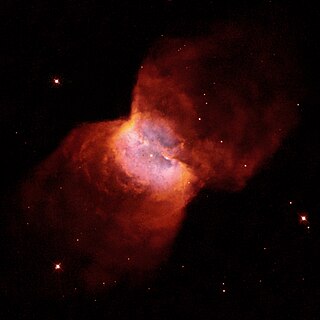
NGC 2346 is a planetary nebula near the celestial equator in the constellation of Monoceros, less than a degree to the ESE of Delta Monocerotis. It is informally known as the Butterfly Nebula. The nebula is bright and conspicuous with a visual magnitude of 9.6, and has been extensively studied. Among its most remarkable characteristics is its unusually cool central star, which is a spectroscopic binary, and its unusual shape.

The Eskimo Nebula, also known as the Clown-faced Nebula, Lion Nebula, or Caldwell 39, is a bipolar double-shell planetary nebula (PN). It was discovered by astronomer William Herschel in 1787. The formation resembles a person's head surrounded by a parka hood. It is surrounded by gas that composed the outer layers of a Sun-like star. The visible inner filaments are ejected by a strong wind of particles from the central star. The outer disk contains unusual, light-year-long filaments.
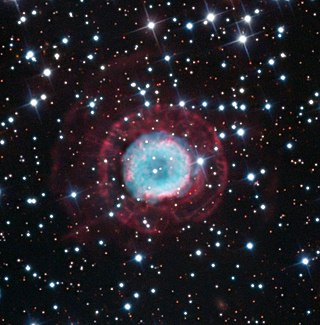
NGC 2438 is a planetary nebula in the southern constellation of Puppis. Parallax measurements by Gaia put the central star at a distance of roughly 1,370 light years. It was discovered by William Herschel on March 19, 1786. NGC 2438 appears to lie within the cluster M46, but it is most likely unrelated since it does not share the cluster's radial velocity.
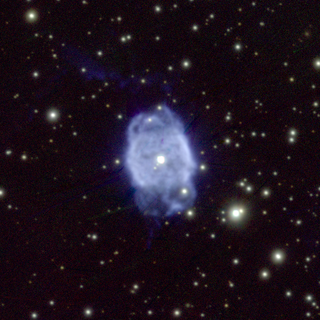
NGC 40 is a planetary nebula discovered by William Herschel on November 25, 1788, and is composed of hot gas around a dying star. The star has ejected its outer layer which has left behind a small, hot star. Radiation from the star causes the shed outer layer to heat to about 10,000 degrees Celsius and become visible as a planetary nebula. The nebula is about one light-year across. About 30,000 years from now, scientists theorize that NGC 40 will fade away, leaving only a white dwarf star approximately the size of Earth.
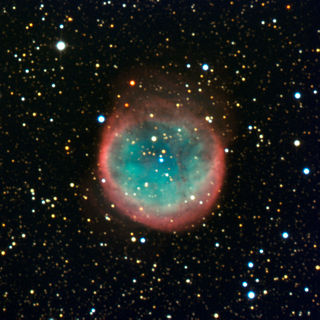
NGC 6781, also known as the Snowglobe Nebula, is a planetary nebula located in the equatorial constellation of Aquila, about 2.5° east-northeast of the 5th magnitude star 19 Aquilae. It was discovered July 30, 1788 by the Anglo-German astronomer William Herschel. The nebula lies at a distance of 1,500 ly from the Sun. It has a visual magnitude of 11.4 and spans an angular size of 1.9 × 1.8 arcminutes.

NGC 2022 is a planetary nebula in the equatorial constellation of Orion, located at a distance of 8.21 kilolight-years from the Sun. It was first observed by William Herschel on December 28, 1785, who described it as: considerably bright, nearly round, like a star with a large diameter, like an ill-defined planetary nebula. In medium-sized amateur telescopes it looks like a small grayish patch of light. It is not very bright but it is still easy to spot it in the eyepiece. Even in a telescope as small as 80mm it can just be seen using a narrowband filter such as an OIII filter as a 'fuzzy' star. The object has the shape of a prolate spheroid with a major to minor axis ratio of 1.2, an apparent size of 28″, and a halo extending out to 40″, which is about the angular diameter of Jupiter as seen from Earth.

NGC 5882 is a small planetary nebula in the southern constellation of Lupus, positioned about 1.5° to the southwest of the star Epsilon Lupi. It was discovered by English astronomer John Herschel on July 2, 1834 from the Cape of Good Hope observatory. John L. E. Dreyer described it as "very small, round, quite sharp". It is located at a distance of approximately 7.7 kilolight-years from the Sun.
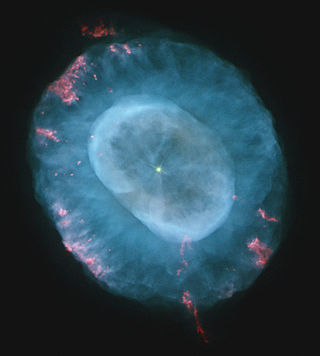
NGC 7662 is a planetary nebula located in the northern constellation Andromeda. It is known as the Blue Snowball Nebula, Snowball Nebula, and Caldwell 22. This nebula was discovered October 6, 1784 by the German-born English astronomer William Herschel. In the New General Catalogue it is described as a "magnificent planetary or annular nebula, very bright, pretty small in angular size, round, blue, variable nucleus". The object has an apparent visual magnitude of 8.3 and spans an angular size of 32″ × 28″. Parallax measurements give a distance estimate of 5,730 ± 340 ly (1,757 ± 103 pc).

NGC 2867 is an elliptical Type II planetary nebula in the southern constellation of Carina, just over a degree to the NNW of the star Iota Carinae. It was discovered by John Herschel on April 1, 1834. Herschel initially thought he might have found a new planet, but on the following night he checked again and discovered it had not moved. The nebula is located at a distance of 7,270 light-years from the Sun.

NGC 3195 is a planetary nebula located in the southern constellation of Chamaeleon. Discovered by Sir John Herschel in 1835, this 11.6 apparent magnitude planetary nebula is slightly oval in shape, with dimensions of 40×35 arc seconds, and can be seen visually in telescopic apertures of 10.5 centimetres (4.1 in) at low magnifications.

NGC 6884 is a planetary nebula located in the constellation Cygnus, less than a degree to the southwest of the star Ο1 Cygni. It lies at a distance of approximately 12.5 kly from the Sun. The nebula was discovered on May 8, 1883, by American astronomer Edward C. Pickering.
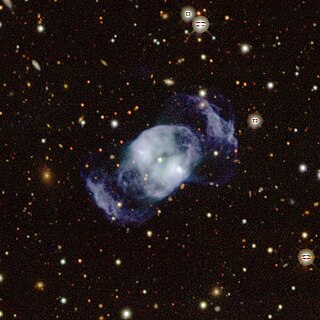
NGC 2371-2 is a dual lobed planetary nebula located in the constellation Gemini. Visually, it appears like it could be two separate objects; therefore, two entries were given to the planetary nebula by John Louis Emil Dreyer in the New General Catalogue, so it may be referred to as NGC 2371, NGC 2372, or variations on this name. It has also been called the double bubble nebula.
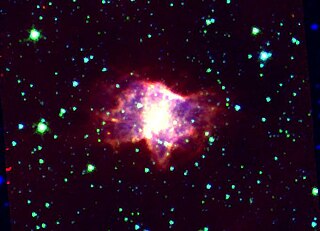
NGC 6072 is a planetary nebulae in the southern constellation of Scorpius. It has a dynamical age of 104 years. Its circumstellar envelope is likely to be rich in carbon as it has very strong CN (cyanide) spectral lines. CN spectral lines are generally not detected in oxygen rich AGB (asymptotic giant branch) circumstellar envelopes. NGC 6072 also shows H2 (hydrogen) emission and intense CO (carbon monoxide) emission which has been mapped displaying bipolarity and some gas at high velocity. The evolution of this planetary nebulae is likely to be dominated by photodissociation and ion/radical molecular reactions. Shock chemistry is also likely to be important.

IC 2448 is an elliptical planetary nebula in the constellation of Carina. It was discovered in 1898 by Williamina Fleming. It lies near the bright star Beta Carinae, and the southern Carina can be explored in the months of autumn in the southern hemisphere. The central star of the planetary nebula is an O-type star with a spectral type of O(H)3 III-V. An analysis of Gaia data suggests that it is a binary system.

Little Ghost Nebula, also known as NGC 6369, is a planetary nebula in the constellation Ophiuchus. It was discovered by William Herschel.

IC 3568 is a planetary nebula that is 1.3 kiloparsecs away from Earth in the constellation of Camelopardalis. It is a relatively young nebula and has a core diameter of only about 0.4 light years. It was dubbed the Lemon Slice Nebula by Jim Kaler, due to its appearance in one false-colour image from the Hubble Space Telescope. The Lemon Slice Nebula is one of the most simple nebulae known, with an almost perfectly spherical morphology. The core of the nebula does not have a distinctly visible structure in formation and is mostly composed of ionized helium. A faint halo of interstellar dust surrounds the nebula. The central star of the planetary nebula is an O-type star with a spectral type of O(H)3.
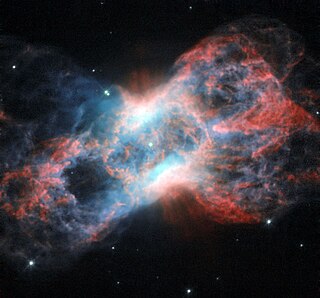
NGC 7026 is a planetary nebula located 6000 light-years away, in the constellation of Cygnus. The central star of the planetary nebula has a spectral type of [WO3], indicating a spectrum similar to that of an oxygen-rich Wolf–Rayet star. An analysis of Gaia data suggests that it is a binary system.

NGC 6153 is a planetary nebula in the constellation Scorpius. It was discovered in 1883 by Ralph Copeland.

NGC 1501 is a complex planetary nebula located in the constellation of Camelopardalis, it was discovered on 27 August 1787 by William Herschel.
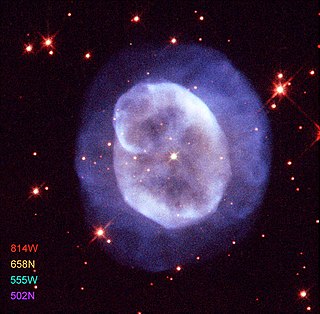
NGC 5979 is a planetary nebula in the constellation Triangulum Australe. It was discovered by John Herschel on April 24, 1835. The central star of the planetary nebula is an O-type star with a spectral type of O(H)3-4.




















